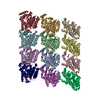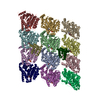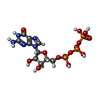[English] 日本語
 Yorodumi
Yorodumi- PDB-9f3b: Undecorated 13pf E254Q microtubule from recombinant human tubulin -
+ Open data
Open data
- Basic information
Basic information
| Entry | Database: PDB / ID: 9f3b | ||||||||||||||||||
|---|---|---|---|---|---|---|---|---|---|---|---|---|---|---|---|---|---|---|---|
| Title | Undecorated 13pf E254Q microtubule from recombinant human tubulin | ||||||||||||||||||
 Components Components |
| ||||||||||||||||||
 Keywords Keywords | STRUCTURAL PROTEIN / Microtubule Tubulin GTP cap Cell cycle | ||||||||||||||||||
| Function / homology |  Function and homology information Function and homology informationnetrin receptor binding / dorsal root ganglion development / Post-chaperonin tubulin folding pathway / Cilium Assembly / cytoskeleton-dependent intracellular transport / Microtubule-dependent trafficking of connexons from Golgi to the plasma membrane / Carboxyterminal post-translational modifications of tubulin / Intraflagellar transport / Sealing of the nuclear envelope (NE) by ESCRT-III / Formation of tubulin folding intermediates by CCT/TriC ...netrin receptor binding / dorsal root ganglion development / Post-chaperonin tubulin folding pathway / Cilium Assembly / cytoskeleton-dependent intracellular transport / Microtubule-dependent trafficking of connexons from Golgi to the plasma membrane / Carboxyterminal post-translational modifications of tubulin / Intraflagellar transport / Sealing of the nuclear envelope (NE) by ESCRT-III / Formation of tubulin folding intermediates by CCT/TriC / Gap junction assembly / Prefoldin mediated transfer of substrate to CCT/TriC / Kinesins / COPI-independent Golgi-to-ER retrograde traffic / Assembly and cell surface presentation of NMDA receptors / COPI-dependent Golgi-to-ER retrograde traffic / Recycling pathway of L1 / RHOH GTPase cycle / RHO GTPases activate IQGAPs / microtubule-based process / Hedgehog 'off' state / intercellular bridge / COPI-mediated anterograde transport / Activation of AMPK downstream of NMDARs / cytoplasmic microtubule / Mitotic Prometaphase / EML4 and NUDC in mitotic spindle formation / peptide binding / MHC class II antigen presentation / cellular response to interleukin-4 / Recruitment of NuMA to mitotic centrosomes / axon guidance / HSP90 chaperone cycle for steroid hormone receptors (SHR) in the presence of ligand / Resolution of Sister Chromatid Cohesion / cell periphery / Translocation of SLC2A4 (GLUT4) to the plasma membrane / filopodium / RHO GTPases Activate Formins / PKR-mediated signaling / structural constituent of cytoskeleton / microtubule cytoskeleton organization / HCMV Early Events / Aggrephagy / The role of GTSE1 in G2/M progression after G2 checkpoint / mitotic spindle / Separation of Sister Chromatids / mitotic cell cycle / lamellipodium / double-stranded RNA binding / microtubule cytoskeleton / growth cone / Hydrolases; Acting on acid anhydrides; Acting on GTP to facilitate cellular and subcellular movement / microtubule / cilium / axon / cell division / neuronal cell body / GTPase activity / dendrite / ubiquitin protein ligase binding / GTP binding / structural molecule activity / extracellular exosome / metal ion binding / nucleus / cytoplasm Similarity search - Function | ||||||||||||||||||
| Biological species |  Homo sapiens (human) Homo sapiens (human) | ||||||||||||||||||
| Method | ELECTRON MICROSCOPY / single particle reconstruction / cryo EM / Resolution: 3.6 Å | ||||||||||||||||||
 Authors Authors | Estevez-Gallego, J. / Blum, T.B. / Steinmetz, M.O. / Surrey, T. | ||||||||||||||||||
| Funding support |  Spain, Spain,  Switzerland, European Union, 5items Switzerland, European Union, 5items
| ||||||||||||||||||
 Citation Citation |  Journal: Nat Commun / Year: 2025 Journal: Nat Commun / Year: 2025Title: Hydrolysis-deficient mosaic microtubules as faithful mimics of the GTP cap. Authors: Juan Estévez-Gallego / Thorsten B Blum / Felix Ruhnow / María Gili / Silvia Speroni / Raquel García-Castellanos / Michel O Steinmetz / Thomas Surrey /   Abstract: A critical feature of microtubules is their GTP cap, a stabilizing GTP-tubulin rich region at growing microtubule ends. Microtubules polymerized in the presence of GTP analogs or from GTP hydrolysis- ...A critical feature of microtubules is their GTP cap, a stabilizing GTP-tubulin rich region at growing microtubule ends. Microtubules polymerized in the presence of GTP analogs or from GTP hydrolysis-deficient tubulin mutants have been used as GTP-cap mimics for structural and biochemical studies. However, these analogs and mutants generate microtubules with diverse biochemical properties and lattice structures, leaving it unclear what is the most faithful GTP mimic and hence the structure of the GTP cap. Here, we generate a hydrolysis-deficient human tubulin mutant, αE254Q, with the smallest possible modification. We show that αE254Q-microtubules are stable, but still exhibit mild mutation-induced growth abnormalities. However, mixing two GTP hydrolysis-deficient tubulin mutants, αE254Q and αE254N, at an optimized ratio eliminates growth and lattice abnormalities, indicating that these 'mosaic microtubules' are faithful GTP cap mimics. Their cryo-electron microscopy structure reveals that longitudinal lattice expansion, but not protofilament twist, is the primary structural feature distinguishing the GTP-tubulin containing cap from the GDP-tubulin containing microtubule shaft. However, alterations in protofilament twist may be transiently needed to allow lattice compaction and GTP hydrolysis. Together, our results provide insights into the structural origin of GTP cap stability, the pathway of GTP hydrolysis and hence microtubule dynamic instability. | ||||||||||||||||||
| History |
|
- Structure visualization
Structure visualization
| Structure viewer | Molecule:  Molmil Molmil Jmol/JSmol Jmol/JSmol |
|---|
- Downloads & links
Downloads & links
- Download
Download
| PDBx/mmCIF format |  9f3b.cif.gz 9f3b.cif.gz | 1 MB | Display |  PDBx/mmCIF format PDBx/mmCIF format |
|---|---|---|---|---|
| PDB format |  pdb9f3b.ent.gz pdb9f3b.ent.gz | 738.9 KB | Display |  PDB format PDB format |
| PDBx/mmJSON format |  9f3b.json.gz 9f3b.json.gz | Tree view |  PDBx/mmJSON format PDBx/mmJSON format | |
| Others |  Other downloads Other downloads |
-Validation report
| Summary document |  9f3b_validation.pdf.gz 9f3b_validation.pdf.gz | 2.3 MB | Display |  wwPDB validaton report wwPDB validaton report |
|---|---|---|---|---|
| Full document |  9f3b_full_validation.pdf.gz 9f3b_full_validation.pdf.gz | 2.4 MB | Display | |
| Data in XML |  9f3b_validation.xml.gz 9f3b_validation.xml.gz | 157 KB | Display | |
| Data in CIF |  9f3b_validation.cif.gz 9f3b_validation.cif.gz | 226.3 KB | Display | |
| Arichive directory |  https://data.pdbj.org/pub/pdb/validation_reports/f3/9f3b https://data.pdbj.org/pub/pdb/validation_reports/f3/9f3b ftp://data.pdbj.org/pub/pdb/validation_reports/f3/9f3b ftp://data.pdbj.org/pub/pdb/validation_reports/f3/9f3b | HTTPS FTP |
-Related structure data
| Related structure data |  50172MC  9f3hC  9f3rC  9f3sC M: map data used to model this data C: citing same article ( |
|---|---|
| Similar structure data | Similarity search - Function & homology  F&H Search F&H Search |
- Links
Links
- Assembly
Assembly
| Deposited unit | 
|
|---|---|
| 1 |
|
- Components
Components
| #1: Protein | Mass: 50732.238 Da / Num. of mol.: 6 Source method: isolated from a genetically manipulated source Source: (gene. exp.)  Homo sapiens (human) / Gene: TUBA1B / Production host: Homo sapiens (human) / Gene: TUBA1B / Production host:  Trichoplusia ni (cabbage looper) / References: UniProt: P68363 Trichoplusia ni (cabbage looper) / References: UniProt: P68363#2: Protein | Mass: 51276.367 Da / Num. of mol.: 6 Source method: isolated from a genetically manipulated source Source: (gene. exp.)  Homo sapiens (human) / Gene: TUBB3, TUBB4 / Production host: Homo sapiens (human) / Gene: TUBB3, TUBB4 / Production host:  Trichoplusia ni (cabbage looper) / References: UniProt: Q13509 Trichoplusia ni (cabbage looper) / References: UniProt: Q13509#3: Chemical | ChemComp-GTP / #4: Chemical | ChemComp-MG / Has ligand of interest | Y | Has protein modification | Y | |
|---|
-Experimental details
-Experiment
| Experiment | Method: ELECTRON MICROSCOPY |
|---|---|
| EM experiment | Aggregation state: HELICAL ARRAY / 3D reconstruction method: single particle reconstruction |
- Sample preparation
Sample preparation
| Component | Name: Undecorated 13pf E254Q microtubule from recombinant human tubulin Type: ORGANELLE OR CELLULAR COMPONENT / Entity ID: #1-#2 / Source: RECOMBINANT |
|---|---|
| Source (natural) | Organism:  Homo sapiens (human) Homo sapiens (human) |
| Source (recombinant) | Organism:  Trichoplusia ni (cabbage looper) Trichoplusia ni (cabbage looper) |
| Buffer solution | pH: 6.8 |
| Specimen | Conc.: 20 mg/ml / Embedding applied: NO / Shadowing applied: NO / Staining applied: NO / Vitrification applied: YES |
| Specimen support | Grid type: C-flat-2/2 |
| Vitrification | Instrument: FEI VITROBOT MARK IV / Cryogen name: ETHANE / Humidity: 100 % / Chamber temperature: 310 K |
- Electron microscopy imaging
Electron microscopy imaging
| Microscopy | Model: TFS GLACIOS |
|---|---|
| Electron gun | Electron source:  FIELD EMISSION GUN / Accelerating voltage: 200 kV / Illumination mode: FLOOD BEAM FIELD EMISSION GUN / Accelerating voltage: 200 kV / Illumination mode: FLOOD BEAM |
| Electron lens | Mode: BRIGHT FIELD / Nominal defocus max: 2500 nm / Nominal defocus min: 1000 nm |
| Image recording | Electron dose: 7.25 e/Å2 / Film or detector model: FEI FALCON IV (4k x 4k) / Num. of grids imaged: 1 / Num. of real images: 3350 |
- Processing
Processing
| EM software |
| ||||||||||||||||||||||||||||
|---|---|---|---|---|---|---|---|---|---|---|---|---|---|---|---|---|---|---|---|---|---|---|---|---|---|---|---|---|---|
| CTF correction | Type: PHASE FLIPPING AND AMPLITUDE CORRECTION | ||||||||||||||||||||||||||||
| Particle selection | Num. of particles selected: 4873 | ||||||||||||||||||||||||||||
| 3D reconstruction | Resolution: 3.6 Å / Resolution method: FSC 0.143 CUT-OFF / Num. of particles: 26585 / Num. of class averages: 1 / Symmetry type: POINT | ||||||||||||||||||||||||||||
| Atomic model building | B value: 190 / Protocol: RIGID BODY FIT / Space: REAL | ||||||||||||||||||||||||||||
| Atomic model building | PDB-ID: 7sj7 Accession code: 7sj7 / Source name: PDB / Type: experimental model | ||||||||||||||||||||||||||||
| Refinement | Cross valid method: NONE Stereochemistry target values: GeoStd + Monomer Library + CDL v1.2 | ||||||||||||||||||||||||||||
| Displacement parameters | Biso mean: 85.69 Å2 | ||||||||||||||||||||||||||||
| Refine LS restraints |
|
 Movie
Movie Controller
Controller





 PDBj
PDBj
































